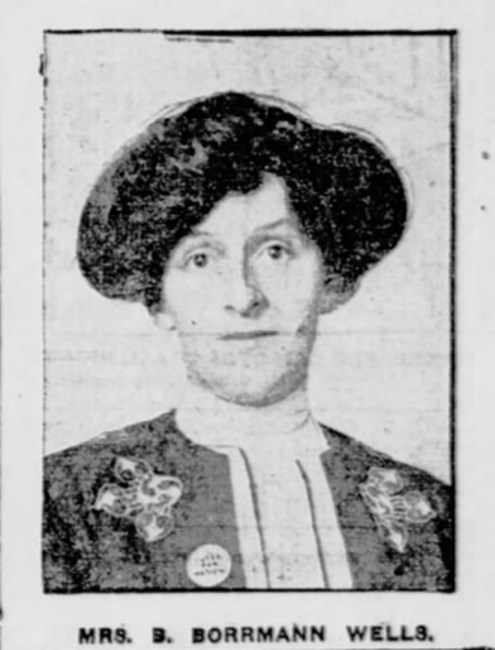Part of a series of articles titled Maud Malone - New York City Librarian and Suffrage Powerhouse.
Article
Maud Malone: Open Air Suffrage Meetings

In the spring of 1907, Maud convinced her fellow members of the Harlem Equal Rights League to adopt one non-violent aspect of the radical English suffragettes: open-air meetings on street corners. She wrote “When…the Harlem Equal Rights League voted to start open air suffrage meetings, it was the idea that it was a great opportunity to present our cause to men and women who would not come to hear the question debated in public halls or private drawing rooms.”[1] Maud was interested in challenging a wide audience of men and women to begin to develop an opinion, positive or negative, about women suffrage.[2]
But who would show up with her to speak? Which fellow club members would risk their reputation to join her? Maud attempted to drag her fellow clubbers out of their hotel banquet halls and onto the streets[3] with this invitation in the New York Times on December 1907:
A ferocious debate arose in women’s clubs across New York City about whether to participate. Most everyone refused, saying that a female speaker would certainly lose everyone’s respect.[5]“The first of a series of open-air meetings will be held on Tuesday, this week. The purpose of these meetings is to focus public attention upon the question of women suffrage and so obtain signatures to the petition for the amendment to our State Constitution obtaining for women the right to suffrage… We women do not believe that we will ever succeed in this state, or elsewhere, unless we bring our agitation for women suffrage over into our public life and make it a question of the day to the great mass of men and women. We think we can do this best by the course of action which we are adopting, and our appeal will be, not to one sort of condition of men and women, but to all sorts. To reach these with the least expenditure of time, money, and labor we have decided to abandon the old methods of renting halls, with all the additional expense involved…”[4]
Maud pushed ahead anyway. She found a location, Madison Square Park, set a date and time and found one male and two female speakers brave enough to join her. Her most important ally was English Suffragette Bettina Borrmann Wells who worked beside her to introduce English tactics to the United States.[6]
The first open air suffrage meeting on December 31, 1907 was a huge success. Over three hundred men and about ten women participated. Hundreds of signatures supporting women's suffrage were collected. Newspapermen wrote glowing reviews of the event. The mostly male audience listened to the speeches by the women and many reconsidered their opinions.[7] Maud pioneered an American version of a question and answer session with male voters. Her Q and A session used humor, sarcasm and insightful ideas about feminism to spark debate and discussion among male voters. At least one influential woman club member lingered on the outskirts of the meeting and witnessed Maud’s triumph.[8]
“She can get his dinner better if she knows he had good wages to provide it,” answered Miss Malone. “Women know as much about politics as men. If you men knew politics, would you have the men in power that you have now in New York?”
“‘That’s Right’ came the voices.” Reported the journalist for the New York Times.[9]
The New York Sun included more of the back and forth:
“Do women know enough to vote?” asked a blond who might have been a grocer’s clerk.
“I guess they know as much as any of you men,” answered the speaker.
“How do you know?”
“Why, I can tell by looking into your faces!” snapped Miss Malone. And the cheers were all for her.” [10]
During the next few months Maud and her team attended women’s club meetings, arguing for the effectiveness of open air meetings.[11] Mirroring the British trend, women like Maud who supported more militant methods began to call themselves “suffragettes,” while those who favored collecting signatures and conducting letter writing campaigns continued to call themselves “suffragists.”[12] Both groups argued furiously about tactics, but remarkably they frequently worked together.[13] Maud often assisted both groups.[14]
Notes:
[2] “Maud Malone Says she is not militant” Brooklyn Daily Eagle, October 31, 1912 p. 4. “…Nobody can be on the fence in such a question as the suffrage. Everyone must have a conviction of some kind or other…”
[5] “Votes for women: Suffragettes adopt English War cry- Conservatives wrathy” The New York Daily Tribune, December 29, 1907. “Mrs. Frederick Nathan, Vice President of the New York Suffrage League does not approve of the plan. ‘They do things that way in England, ‘she said, ‘but it isn’t the way for America. Our population is too heterogeneous to be moved by such methods.”
“Women Suffragists not all in harmony: Some of the leaders doubtful about the advisability of open air meetings here, one set or Tuesday next.” The New York Times December 29, 1907.
“First gun fired, Female Revolutionists” The New York Daily Tribune January 1, 1908. “Miss Maud Malone the general of the Suffragette army, challenged the audience to ask questions.”
“Suffragist or Suffragette” The New York Times, February 29, 1908 “She has attended the open air meetings at Madison Square as a listener.”
Last updated: July 5, 2019
